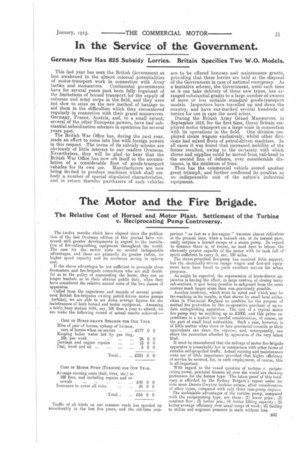In the Service of the Government.
Page 57

If you've noticed an error in this article please click here to report it so we can fix it.
Germany Now Has 825 Subsidy Lorries. Britain Specifies Two W.O. Models.
This last year has seen the British Government at last awakened to the almost colossal potentialities of motor-transport work in connection with Army tactics and manceuvres. Continental governments have for several years past been fully cognisant of the limitations of horsed transport for the supply of columns and army corps in the field, and they were not slow to seize on the new method of haulage to aid them in the difficulties which they encountered regularly in connection with their grand naanceuvres. Germany, France, Austria, and, to a small extent, several of the other European powers, have had substantial subsidization schemes in operation for several years past. The British War Office ha.sl during the past year, made an effort to come into line with foreign powers in this respect. The terms of its subsidy scheme are obviously of little interest to our readers Overseas. Nevertheless, they will be glad to hear that the British War Office has now set itself to the accumulation of a oonsiderable fleet of goods-transport vehicles for its own use. Manufacturers are now being invited to produce machines which shall embody a number of special stipulated characteristics, and in return therefor purchasers of such vehicles
are to be offered bonuses and maintenance grants, providing that these lorries are held at the disposal of the Government in case of national emergency. As a tentative scheme, the Government, until such time as it can take delivery of these new types, has arranged substantial grants to a large number of owners of more or less suitable standard goods-transport models. Inspectors have travelled up and down the country, and have ear-marked several hundreds of lorries for use in case the need arises.
During the British Army Grand Manceuvres. in September 1912, for the first time, Great Britain employed motor transport on a. large scale in connection with its operations in the field. One division employed steam wagons exclusively, whilst other divistone had mixed fleets of petrol-driven machines, In all cases it was found that increased mobility of the forces resulted, owing to the certainty with which stores and supplies could be moved from rail-head to the second line of defence, over considerable distances, in the minimum of time.
Thus has the commercial vehicle scored another great triumph, and further confirmed its position as an indispensable unit of the nation's industrial equipment.


























































































